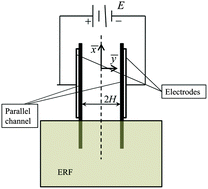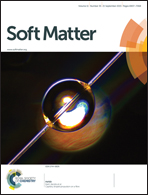Electro-capillary effects in capillary filling dynamics of electrorheological fluids†
Abstract
The flow of electrorheological fluids is characterized by an apparent increase in viscosity manifested by the yield stress property of the fluid, which is a function of the applied electric field and the concentration of the suspended solute phase within the dielectric medium. This property of electrorheological fluids generally hinders flow through a capillary if the imposed shear stress is lower than the induced yield stress. This results in a plug-like zone in the flow profile, thus giving the fluid Bingham plastic properties. In the present work, we study such influences of the yield stress on the capillary filling dynamics of an electrorheological fluid by employing a rheologically consistent reduced order formalism. One important feature of the theoretical formalism is its ability to address the intricate interplay between the surface tension and viscous forces, both of which depend sensitively on the electric field. Our analysis reveals that the progress of the capillary front is hindered at an intermediate temporal regime, which is attributable to the increase of the span of the plug-zone across the channel width with time. With a preliminary understanding on the cessation of the capillary front advancement due to the yield stress property of the electrorheological fluids, we further strive to achieve a basic comparison with an experimental study made earlier. Reasonable agreements with the reported data support our theoretical framework. Comprehensive scaling analysis brings further insight to our reported observations over various temporal regimes.


 Please wait while we load your content...
Please wait while we load your content...